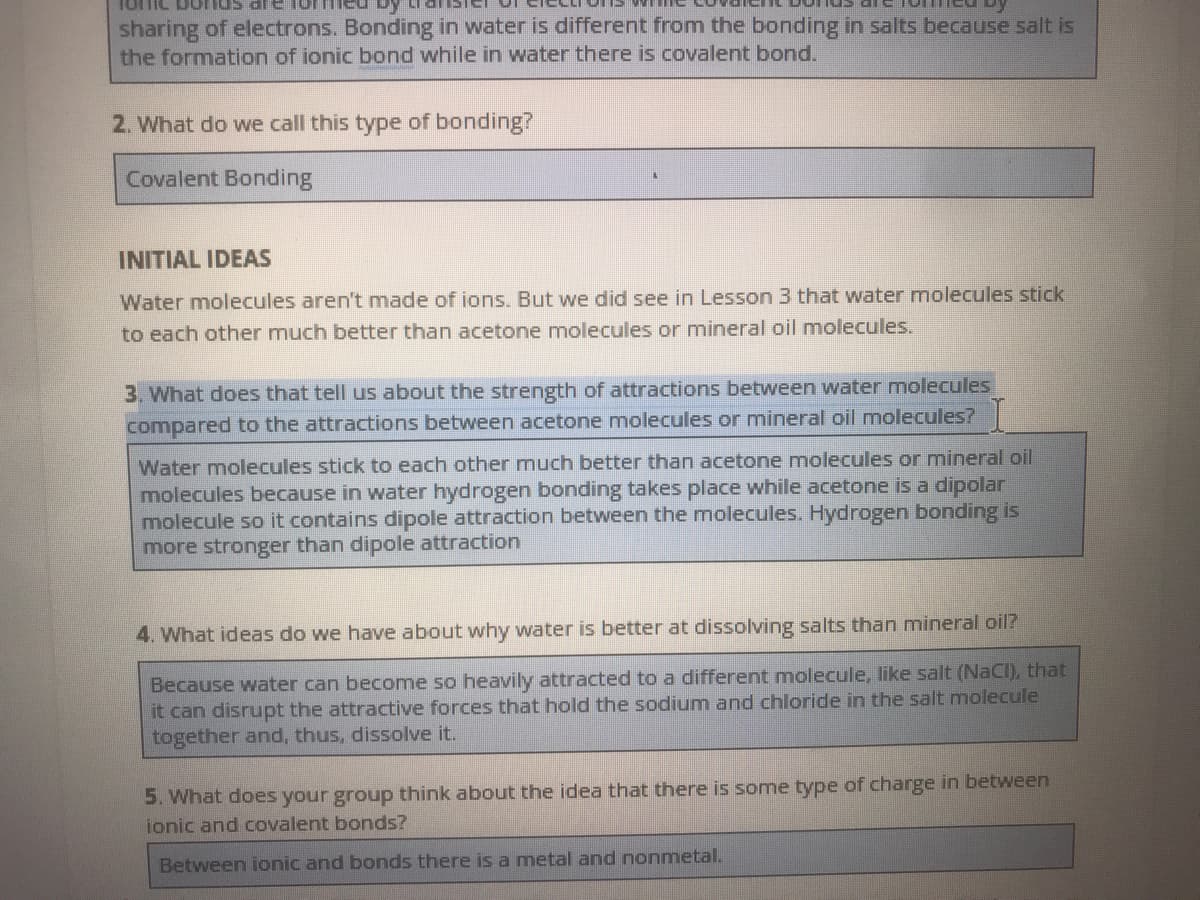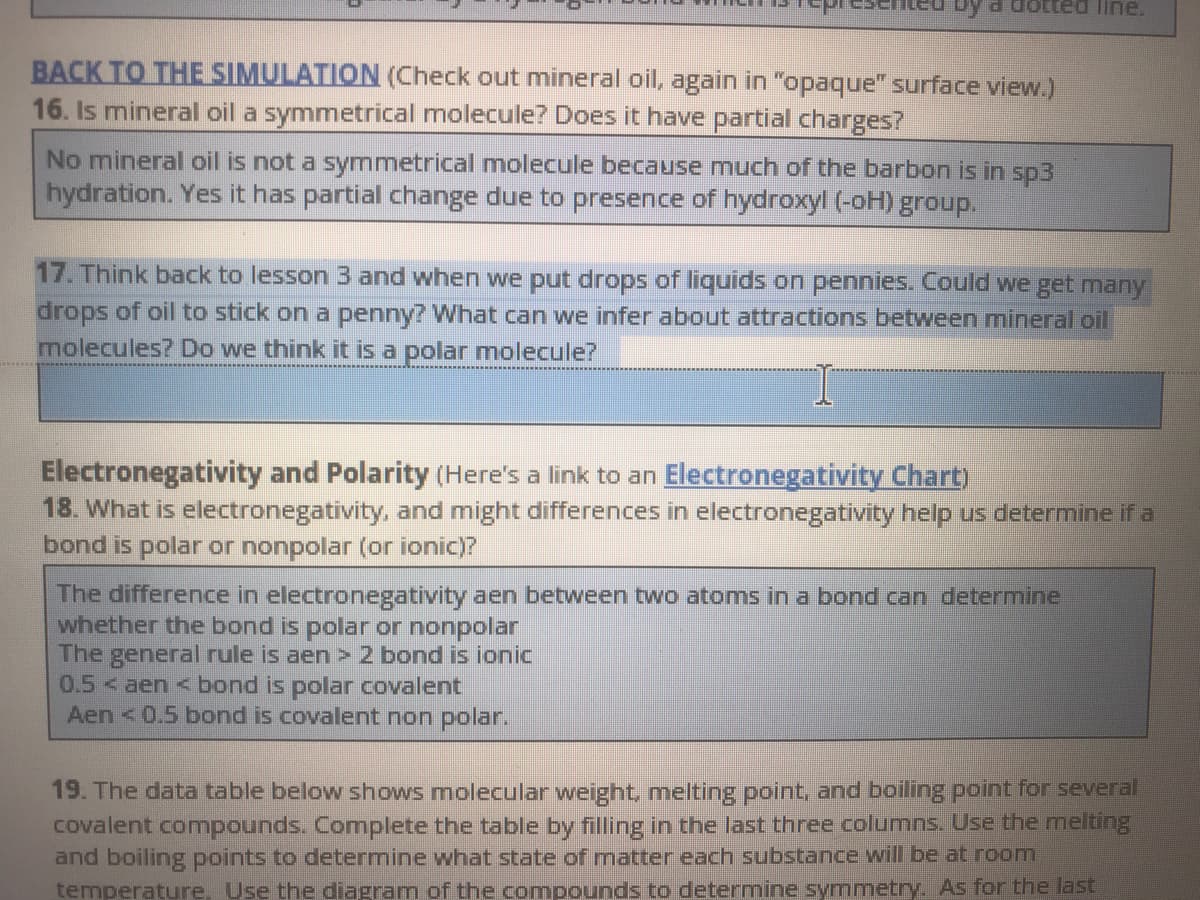Chapter4: Molecules, Compounds, And Chemical Reactions
Section: Chapter Questions
Problem 58E
Related questions
Question
Solve for question 17 please and use question 3 to solve for question 17, short answer please, thanks

Transcribed Image Text:sharing of electrons. Bonding in water is different from the bonding in salts because salt is
the formation of ionic bond while in water there is covalent bond.
2. What do wve call this type of bonding?
Covalent Bonding
INITIAL IDEAS
Water molecules aren't made of ions. But we did see in Lesson 3 that water molecules stick
to each other much better than acetone molecules or mineral oil molecules.
3. What does that tell us about the strength of attractions between water molecules
compared to the attractions between acetone molecules or mineral oil molecules?
Water molecules stick to each other much better than acetone molecules or mineral oil
molecules because in water hydrogen bonding takes place while acetone is a dipolar
molecule so it contains dipole attraction between the molecules. Hydrogen bonding is
more stronger than dipole attraction
4. What ideas do we have about why water is better at dissolving salts than mineral oil?
Because water can become so heavily attracted to a different molecule, like salt (NaCI), that
it can disrupt the attractive forces that hold the sodium and chloride in the salt molecule
together and, thus, dissolve it.
5. What does your group think about the idea that there is some type of charge in between
ionic and covalent bonds?
Between ionic and bonds there is a metal and nonmetal.

Transcribed Image Text:d dotted line.
BACK TO THE SIMULATION (Check out mineral oil, again in "opaque" surface view.)
16. Is mineral oil a symmetrical molecule? Does it have partial charges?
No mineral oil is not a symmetrical molecule because much of the barbon is in sp3
hydration. Yes it has partial change due to presence of hydroxyl (-oH) group.
17. Think back to lesson 3 and when we put drops of liquids on pennies. Could we get many
drops of oil to stick on a penny? What can we infer about attractions between mineral oil
molecules? Do we think it is a polar molecule?
Electronegativity and Polarity (Here's a link to an Electronegativity Chart)
18. What is electronegativity, and might differences in electronegativity help us determine if a
bond is polar or nonpolar (or ionic)?
The difference in electronegativity aen between two atoms in a bond can determine
whether the bond is polar or nonpolar
The general rule is aen > 2 bond is ionic
0.5< aen < bond is polar covalent
Aen <0.5 bond is covalent non polar.
19. The data table below shows molecular weight, melting point, and boiling point for several
covalent comnpounds. Complete the table by filling in the last three columns. Use the melting
and boiling points to determine what state of matter each substance will be at room
temperature, Use the diagram of the compounds to determine symmetry. As for the last
Expert Solution
This question has been solved!
Explore an expertly crafted, step-by-step solution for a thorough understanding of key concepts.
This is a popular solution!
Trending now
This is a popular solution!
Step by step
Solved in 2 steps with 1 images

Recommended textbooks for you


Living By Chemistry: First Edition Textbook
Chemistry
ISBN:
9781559539418
Author:
Angelica Stacy
Publisher:
MAC HIGHER


Living By Chemistry: First Edition Textbook
Chemistry
ISBN:
9781559539418
Author:
Angelica Stacy
Publisher:
MAC HIGHER